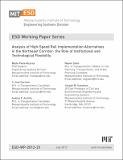Analysis of High-Speed Rail Implementation Alternatives in the Northeast Corridor: the Role of Institutional and Technological Flexibility
| dc.contributor.author | Pena-Alcaraz, Maite | |
| dc.contributor.author | Carlson, S. Joel | |
| dc.contributor.author | Archila, Andres F. | |
| dc.contributor.author | Stein, Naomi | |
| dc.contributor.author | Sussman, Joseph M. | |
| dc.date.accessioned | 2016-06-03T16:33:01Z | |
| dc.date.available | 2016-06-03T16:33:01Z | |
| dc.date.issued | 2012-07 | |
| dc.identifier.uri | http://hdl.handle.net/1721.1/102937 | |
| dc.description.abstract | In this paper, an engineering systems framework using the CLIOS Process, scenario analysis, and flexibility analysis is used to study the implementation of a high-speed rail corridor in the Northeast Corridor of the United States. Given the tremendous uncertainty that characterizes high-speed rail projects, the implementation of the alternatives proposed, which are very similar to other commonly accepted ways to implement high-speed rail in the corridor, are analyzed under different scenarios. The results motivate incorporation of flexibility into the alternatives to allow decision makers to adapt as situations evolve. While designing-in this flexibility has a cost, it may facilitate the implementation of the alternatives by enabling adaptation to uncertain outcomes, thereby improving performance. | en_US |
| dc.language.iso | en_US | en_US |
| dc.publisher | Massachusetts Institute of Technology. Engineering Systems Division | en_US |
| dc.relation.ispartofseries | ESD Working Papers;ESD-WP-2012-23 | |
| dc.title | Analysis of High-Speed Rail Implementation Alternatives in the Northeast Corridor: the Role of Institutional and Technological Flexibility | en_US |
| dc.type | Working Paper | en_US |
